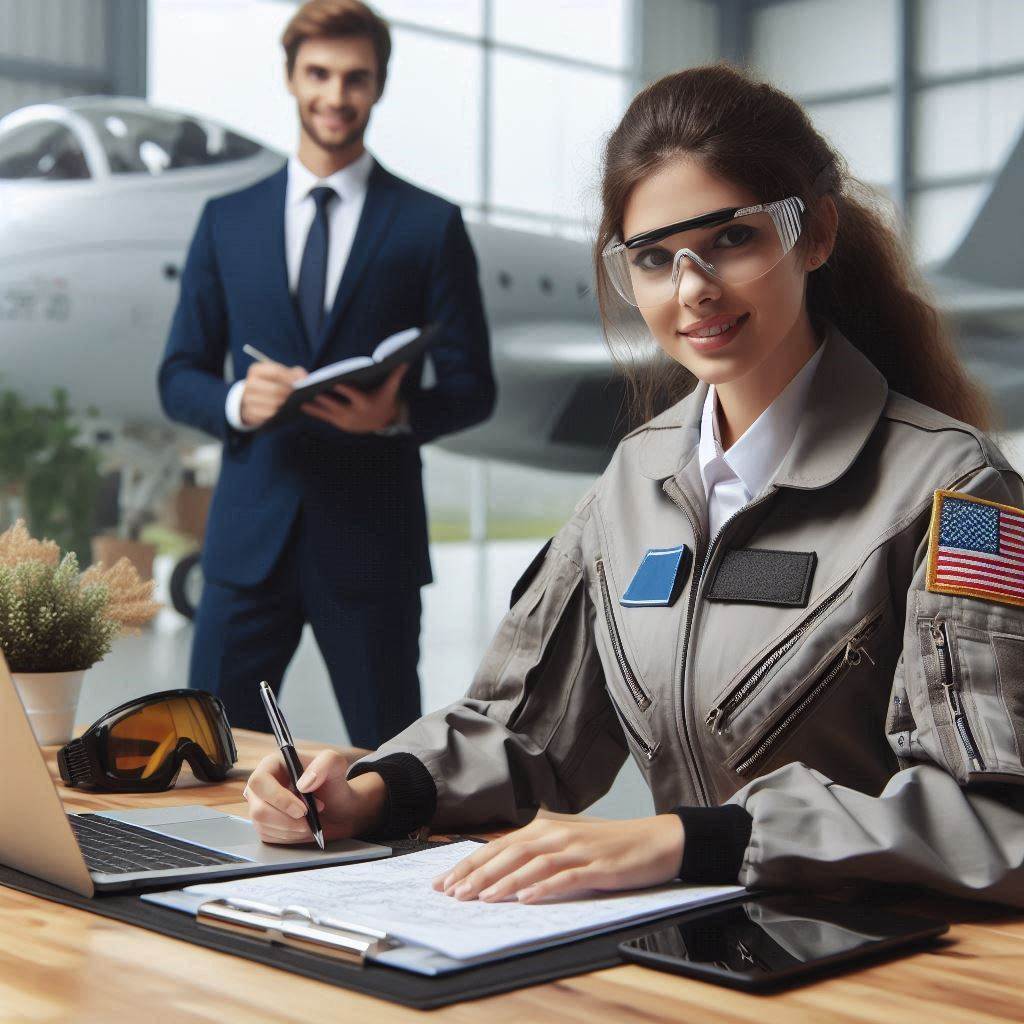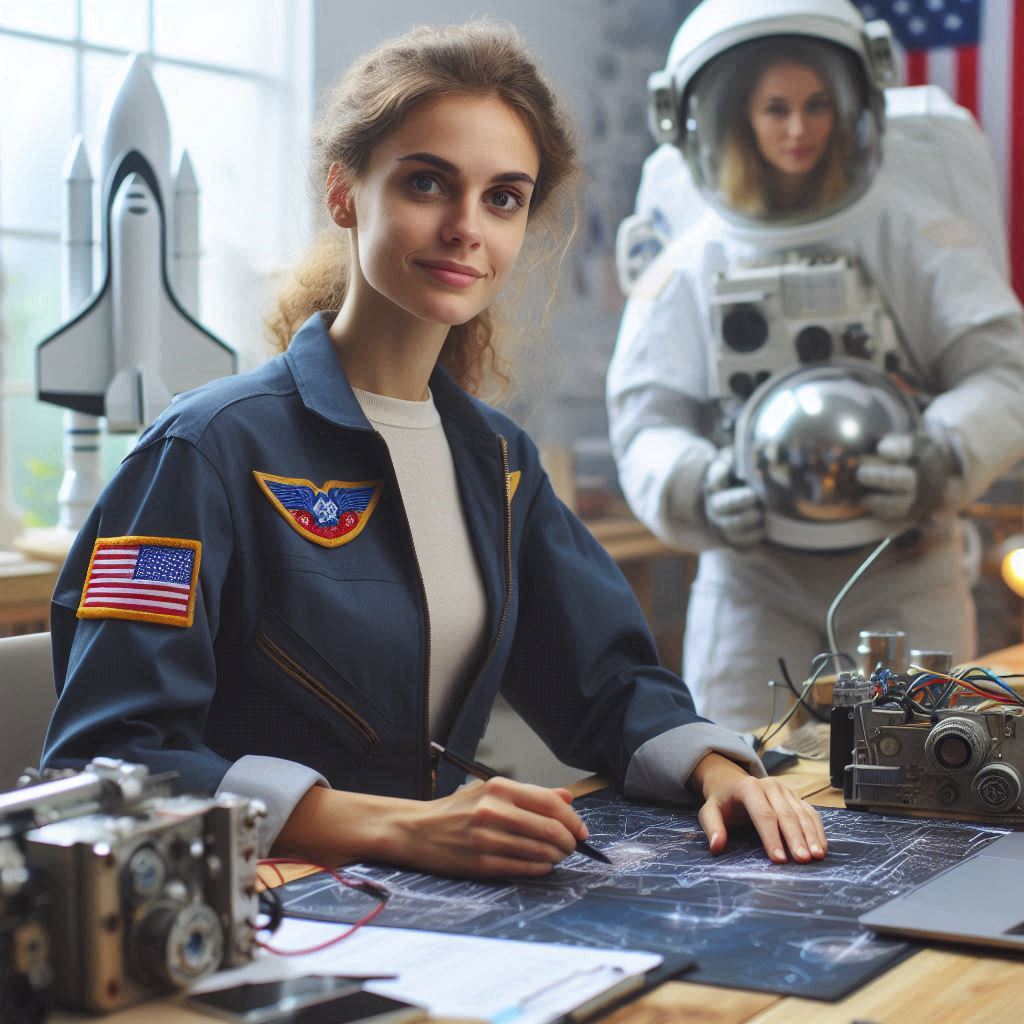Introduction
Aerospace engineers play a crucial role in advancing aviation and space exploration.
They design and develop aircraft, spacecraft, satellites, and missiles, ensuring safety and efficiency.
Key projects highlight their skills and expertise, demonstrating the importance of their work.
One notable project is the development of commercial airliners.
Aerospace engineers work on designing fuel-efficient and environmentally friendly planes.
Their innovations improve passenger safety and comfort, showcasing their technical prowess.
Another significant project is the Mars Rover missions.
Aerospace engineers design and build rovers that explore the Martian surface, collecting valuable data for scientific research.
Their expertise in robotics, materials science, and propulsion systems is essential for the success of these missions.
Additionally, engineers contribute to the International Space Station (ISS).
They develop life support systems, modules, and robotic arms, enabling astronauts to live and work in space.
These projects exemplify the collaborative and multidisciplinary nature of aerospace engineering.
Therefore, aerospace engineers are vital to aviation and space exploration.
Their involvement in commercial airliners, Mars Rover missions, and the ISS highlights their technical expertise and innovative spirit.
These key projects underscore the importance of aerospace engineers in shaping our future.
Project 1: Design and development of next-generation aircraft
Description of the Process Involved in Creating Innovative Aircraft Designs
Creating innovative aircraft designs involves several critical steps.
The process begins with defining the project‘s objectives and requirements.
Aerospace engineers work closely with clients and stakeholders to outline performance criteria.
They conduct extensive research to understand current limitations and opportunities for innovation.
Engineers then move on to conceptual design.
This phase includes generating initial design ideas and evaluating their feasibility.
Engineers use computer-aided design (CAD) software to create detailed models.
These models help visualize the aircraft and assess its aerodynamics.
Next, engineers perform simulations and testing.
Computational fluid dynamics (CFD) software evaluates airflow and performance characteristics.
Physical prototypes may be built for wind tunnel testing to validate the design.
Engineers analyze test data to refine the design and address any issues.
After finalizing the design, engineers oversee the manufacturing process.
They ensure that materials and components meet quality and safety standards.
The assembly of the aircraft is carefully monitored to ensure precision and adherence to specifications.
Finally, extensive testing is conducted to ensure the aircraft meets all performance and safety criteria.
Test flights are performed to evaluate the aircraft‘s behavior under various conditions.
Engineers make adjustments based on test results before the aircraft is approved for commercial use.
Recent Advancements in Aircraft Technology
Supersonic Jets
Supersonic jets represent a significant advancement in aircraft technology.
These aircraft travel faster than the speed of sound, reducing travel times drastically.
Companies like Boom Supersonic are developing commercial supersonic jets that aim to cut flight times by more than half.
These jets feature advanced materials and aerodynamic designs to handle the challenges of supersonic flight, such as sonic booms.
Supersonic jets are also incorporating noise reduction technologies to minimize environmental impact.
Innovations in engine design and materials help manage the high-speed pressures and temperatures.
These advancements promise a new era of faster and more efficient air travel.
Electric Planes
Electric planes are another groundbreaking advancement in aircraft technology.
These planes use electric propulsion systems powered by batteries or fuel cells.
Electric propulsion offers numerous benefits, including reduced emissions and lower operating costs.
Companies like Joby Aviation and Alice are pioneering the development of electric aircraft for short-haul flights.
Electric planes are designed for urban air mobility, offering potential solutions for congested transportation networks.
They feature quiet, efficient engines and advanced battery technologies that make them suitable for commercial and personal use.
Electric planes also emphasize sustainability, aiming to reduce the aviation industry‘s carbon footprint.
Engineers are focusing on improving battery life and power density to extend range and performance.
These advancements are paving the way for a cleaner and more efficient future in aviation.
Creating innovative aircraft designs involves a meticulous process from conceptualization to testing.
Engineers play a crucial role in developing new technologies that enhance performance and safety.
Recent advancements, such as supersonic jets and electric planes, highlight the industry‘s commitment to innovation.
Supersonic jets aim to revolutionize travel times, while electric planes promise a more sustainable future.
These key projects reflect the dynamic and evolving nature of aerospace engineering, driving progress in aviation technology.
Project 2: Space Exploration Missions
Aerospace engineers play a crucial role in designing spacecraft for missions to Mars, the Moon, and beyond.
Pushing the boundaries of human exploration in the vast expanse of space.
Overview of the Role of Aerospace Engineers in Designing Spacecraft for Missions to Mars, Moon, and Beyond
Aerospace engineers play a crucial role in designing spacecraft for missions to Mars, the Moon, and beyond.
They develop innovative spacecraft capable of enduring harsh space environments.
These engineers work on designing propulsion systems to propel spacecraft across vast distances.
They create aerodynamic designs to optimize spacecraft performance during launch and re-entry.
Aerospace engineers focus on developing life support systems to sustain astronauts on long-duration missions.
They design systems for air, water, and food, ensuring crew safety and comfort.
Engineers also work on thermal control systems to manage extreme temperatures in space.
They design shielding to protect spacecraft from space radiation and micrometeoroids.
Engineers are involved in mission planning and simulation.
They conduct tests to ensure spacecraft can handle the rigors of space travel.
Aerospace engineers simulate space environments to test spacecraft designs and components.
They work closely with scientists to ensure that spacecraft can meet mission objectives.
Challenges and Technical Aspects of Space Exploration Projects
Designing spacecraft for space exploration involves numerous challenges and technical complexities.
One major challenge is developing propulsion systems that can achieve high speeds and efficiently traverse space.
Engineers must design engines that work reliably in the vacuum of space and endure long durations.
Thermal control is another critical challenge.
Spacecraft experience extreme temperatures in space, from freezing cold to intense heat.
Engineers must create systems that maintain stable temperatures for both spacecraft and its instruments.
Spacecraft must withstand the harsh space environment, including radiation and micrometeoroids.
Engineers design protective shielding to safeguard sensitive equipment and crew.
They also develop robust structural designs to handle the stresses of launch, space travel, and landing.
Designing for long-duration missions presents unique challenges.
Life support systems must be reliable and capable of supporting astronauts for extended periods.
Engineers work on closed-loop systems that recycle air, water, and waste.
They also ensure that spacecraft have redundant systems to handle potential failures.
Communication is another technical aspect of space exploration.
Engineers design systems to maintain communication between spacecraft and Earth over vast distances.
Finally, budget constraints and time limitations impact spacecraft design.
Engineers must balance innovative solutions with cost-effectiveness and project timelines.
They work to deliver high-performance spacecraft within the constraints of available resources.
Aerospace engineers are integral to designing spacecraft for missions to Mars, the Moon, and beyond.
They tackle numerous challenges, from developing advanced propulsion systems to managing thermal control.
Spacecraft must be resilient to space environments, with reliable life support systems and robust communication capabilities.
The complexities of space exploration require careful planning, testing, and integration.
Aerospace engineers address these challenges with innovative solutions and thorough testing.
Their work enables humanity to explore and understand our solar system and beyond, pushing the boundaries of space exploration.
Project 3: Satellite technology
When it comes to the world of aerospace engineering, one key project that stands out is the development of satellite technology.
Aerospace engineers play a crucial role in designing, launching satellites for various purposes such as communication, weather monitoring, and scientific research.
How Aerospace Engineers Contribute to the Development of Satellites
Aerospace engineers play a crucial role in developing satellites used for various purposes.
They design, build, and test satellites for communication, weather monitoring, and scientific research.
Their expertise ensures that these satellites operate effectively and reliably in space.
In satellite development, engineers focus on several key areas.
They design the satellite’s structure to withstand the harsh conditions of space.
Engineers select and integrate the appropriate materials to ensure durability and performance.
Engineers also work on satellite systems, including propulsion, power, and communication.
They develop propulsion systems to position and maneuver satellites in orbit.
Power systems, such as solar panels and batteries, are designed to keep the satellite operational.
Communication systems are another critical aspect.
Engineers design and implement antennas and transponders to facilitate data transmission between the satellite and ground stations.
This enables real-time communication and data transfer.
During the development phase, aerospace engineers conduct rigorous testing.
They simulate space conditions to ensure that the satellite will function as intended.
Engineers perform tests on satellite components and systems to verify their reliability and performance.
Examples of Successful Satellite Projects That Have Revolutionized Our Understanding
Several satellite projects have significantly advanced our understanding of Earth and space.
One notable example is the Hubble Space Telescope.
Launched in 1990, it has provided breathtaking images and valuable data about distant galaxies, black holes, and cosmic phenomena.
Hubble‘s observations have greatly expanded our knowledge of the universe.
Another groundbreaking project is the Global Positioning System (GPS).
Originally developed for military use, GPS satellites now provide precise location and timing information worldwide.
This technology has transformed navigation, enabling accurate location tracking for various applications, including smartphones and transportation.
The Landsat satellites have revolutionized Earth observation.
Since the first Landsat satellite was launched in 1972, these satellites have provided continuous imagery of Earth’s surface.
The data from Landsat satellites have been crucial for studying land use, deforestation, and environmental changes.
Aerospace engineers are essential to the development of satellites for communication, weather monitoring, and scientific research.
They design and test satellite systems to ensure reliability and performance in space.
Their work enables satellites to perform crucial functions and provide valuable data.
Successful satellite projects, such as the Hubble Space Telescope, GPS, Landsat satellites.
The James Webb Space Telescope, have revolutionized our understanding of Earth and the universe.
These projects have expanded our knowledge, improved navigation, and provided critical data for environmental monitoring.
The contributions of aerospace engineers to satellite development highlight their impact on science and technology.
Their expertise continues to drive advancements that shape our understanding of the world and beyond.
Read: How US Architects Adapt to Climate Change Concerns
Project 4: Defense and military aircraft
Defense and military aircraft are crucial components of a nation’s security and play a vital role in ensuring national defense.
Aerospace engineers are at the forefront of designing and developing advanced military aircraft that meet the stringent requirements of defense purposes.
The Role of Aerospace Engineers in Designing Advanced Military Aircraft for National Defense Purposes
Aerospace engineers play a critical role in designing advanced military aircraft for national defense.
They work on developing aircraft that meet stringent performance and safety requirements.
Engineers collaborate with military officials to understand the specific needs and threats the aircraft must address.
The design process begins with defining mission parameters, such as speed, range, and payload capacity.
Engineers focus on integrating cutting-edge technologies into the aircraft.
These include stealth capabilities, advanced avionics, and electronic warfare systems.
The goal is to create aircraft that are agile, resilient, and capable of operating in hostile environments.
Engineers also consider the aircraft’s survivability, ensuring it can withstand attacks and perform under combat conditions.
The development of military aircraft often involves classified information and secure communication channels.
Engineers must adhere to strict confidentiality protocols and ensure that sensitive technology is protected.
Collaboration with defense contractors and government agencies is essential to meet project timelines and specifications.
The Complexity and Requirements of Military Aircraft Projects
Designing military aircraft is a complex and demanding process.
These projects require a deep understanding of aerodynamics, materials science, and propulsion systems.
Engineers must account for various factors, such as weight limitations, fuel efficiency, and combat readiness.
The aircraft’s design must balance speed, maneuverability, and durability, which are critical for mission success.
One of the most significant challenges in military aircraft projects is integrating advanced technology.
Engineers work on incorporating systems like radar, communication networks, and weapons platforms.
These systems must be seamlessly integrated into the aircraft’s design, maintaining optimal performance while minimizing weight and space usage.
Military aircraft also require rigorous testing and validation.
Engineers conduct simulations and use wind tunnels to test aerodynamics and structural integrity.
Prototypes undergo extensive ground and flight testing to ensure they meet all operational requirements.
This testing phase is crucial for identifying potential issues and making necessary adjustments before full-scale production.
The manufacturing process for military aircraft is also complex.
It involves specialized materials and components that must meet high standards of quality and reliability.
Engineers oversee the production process, ensuring that all parts are manufactured and assembled to precise specifications.
Quality control is paramount, as any failure could compromise the aircraft’s performance and safety.
Aerospace engineers are integral to the design and development of advanced military aircraft.
These projects are complex, requiring a balance of innovative technology and stringent performance criteria.
Engineers must navigate challenges related to stealth, avionics, and survivability, ensuring the aircraft can operate effectively in combat situations.
The complexity of military aircraft projects highlights the need for meticulous planning, testing, and quality control.
Through their expertise and dedication, aerospace engineers contribute significantly to national defense, developing aircraft that safeguard and advance national interests.
Read: Diversity in the US Architectural Scene: A Deep Dive

Project 5: Unmanned Aerial Vehicles (UAVs)
Unmanned aerial vehicles (UAVs) have become increasingly important in various industries due to their versatility and capabilities.
They are used in sectors such as agriculture, surveillance, and disaster relief, making them a valuable tool for many applications.
Growing Importance of UAVs
UAVs have revolutionized the way tasks are carried out in different industries.
In agriculture, these vehicles are used for crop monitoring, spraying pesticides, and even for crop dusting.
They offer a cost-effective and efficient solution for farmers to manage their fields.
When it comes to surveillance, UAVs provide a discreet and reliable way to gather information from above.
Law enforcement agencies use drones for monitoring crowds, tracking suspects, and conducting search and rescue operations.
The aerial view provided by UAVs can be crucial in situations where ground access is limited or dangerous.
During disaster relief operations, UAVs play a vital role in assessing the extent of damage, locating survivors, and delivering essential supplies to affected areas.
Their ability to quickly navigate through disaster zones and capture high-resolution images helps response teams make informed decisions and prioritize resources effectively.
Design and Application by Aerospace Engineers
Aerospace engineers are at the forefront of designing and developing UAVs that meet the specific requirements of different industries.
They combine their expertise in aerodynamics, materials science, and propulsion systems to create drones that are efficient, reliable, and safe to operate.
Transform Your Career Today
Unlock a personalized career strategy that drives real results. Get tailored advice and a roadmap designed just for you.
Start NowThe design process of UAVs involves optimizing their structure for maximum performance and endurance.
Aerospace engineers use advanced software tools to simulate the flight characteristics of drones and improve their aerodynamic efficiency.
They also focus on reducing weight and enhancing stability to ensure smooth and agile flight operations.
Additionally, aerospace engineers work on integrating sensors, cameras, and communication systems into UAVs to enhance their capabilities.
These technologies allow drones to collect real-time data, perform autonomous operations, and communicate with ground control stations effectively.
Aerospace engineers also address challenges related to power management, navigation, and durability to ensure the overall success of UAV missions.
In general, unmanned aerial vehicles represent a significant advancement in aerospace technology.
Driven by the constant innovation and expertise of aerospace engineers.
As the demand for UAVs continues to grow across various industries.
Aerospace engineers will play a crucial role in shaping the future of autonomous aerial operations.
Read: Freelance vs. Firm: Career Paths for US Architects
Delve into the Subject: Ethical Issues in Transportation Engineering
Project 6: Hypersonic technology
As aerospace engineers continue to push the boundaries of flight, hypersonic technology has emerged as an exciting field with immense potential.
Hypersonic flight refers to speeds greater than five times the speed of sound, presenting unique challenges for engineers.
Description of Hypersonic Flight
Hypersonic flight involves speeds exceeding Mach 5, or five times the speed of sound, which is approximately 3,800 mph at sea level.
At these velocities, vehicles experience extreme temperatures and aerodynamic forces.
Making the design and development of hypersonic vehicles incredibly complex.
Challenges Faced by Aerospace Engineers
One of the key challenges faced by aerospace engineers in developing hypersonic vehicles is managing the intense heat generated by air friction at such high speeds.
Materials used in the construction of these vehicles must withstand temperatures exceeding 2,000 degrees Celsius.
Additionally, aerodynamic forces at hypersonic speeds can cause unstable airflow around the vehicle, leading to control issues.
Engineers must design vehicles with precise aerodynamic profiles to ensure stability and control throughout the flight.
Ongoing Research and Development Projects
- NASA’s X-43A: NASA’s X-43A program was one of the first successful demonstrations of scramjet-powered hypersonic flight. The X-43A reached speeds of Mach 9.6 during its test flights, showcasing the potential of scramjet technology.
- DARPA’s Hypersonic Technology Vehicle 2 (HTV-2): DARPA’s HTV-2 program aimed to develop a hypersonic vehicle capable of reaching speeds of Mach 20. Although the program faced challenges, it highlighted the importance of hypersonic technology in military applications.
- Boeing’s X-51A Waverider: Boeing’s X-51A Waverider was another successful hypersonic flight program that demonstrated the viability of hypersonic vehicles. The X-51A reached speeds of Mach 5, showcasing the potential for future hypersonic platforms.
Overall, hypersonic technology represents a cutting-edge field that is shaping the future of aerospace engineering.
With ongoing research and development projects pushing the boundaries of flight.
Aerospace engineers are at the forefront of innovation in hypersonic technology.
Read: Iconic US Buildings and the Architects Behind Them.
Find Out More: Licensing Requirements for Solar Photovoltaic Installers
Project 7: Aeroelasticity and Structural Dynamics
Aeroelasticity and structural dynamics play a crucial role in the design and performance of aircraft.
These aspects are essential for ensuring aircraft stability, reducing structural fatigue, and improving overall safety in aviation.
Importance of Aeroelasticity and Structural Dynamics
Aeroelasticity focuses on the interactions between aerodynamic forces and structural dynamics of an aircraft.
It is essential to understand how these forces affect the aircraft’s behavior, especially during flight conditions, such as turbulence or maneuvers.
Structural dynamics, on the other hand, deals with the response of aircraft structures to dynamic loads, such as vibrations, impacts, or aerodynamic forces.
It is crucial for predicting and analyzing the structural integrity and fatigue life of aircraft components.
Both aeroelasticity and structural dynamics are vital for ensuring the safety, performance, and efficiency of aircraft.
By studying and optimizing these aspects, aerospace engineers can enhance the design, stability, and overall structural health of aircraft.
Projects focusing on Aeroelasticity and Structural Dynamics
- Wind Tunnel Testing: Wind tunnel experiments are conducted to study the aeroelastic behavior of aircraft components, such as wings, tail surfaces, and fuselage. These tests help engineers understand how aerodynamic forces interact with the structure and identify potential issues that may affect stability and performance.
- Finite Element Analysis: Finite element analysis (FEA) is used to simulate and analyze the structural response of aircraft components under different loading conditions. This technique enables engineers to predict stress distribution, deformation, and fatigue life of critical parts, helping them optimize the design for improved performance and durability.
- Modal Analysis: Modal analysis is a method used to determine the natural frequencies, modes, and damping ratios of aircraft structures. By analyzing these dynamic characteristics, engineers can identify potential instabilities, resonance effects, or vibration modes that could compromise the structural integrity and performance of the aircraft.
- Flutter Analysis: Flutter is a self-excited aeroelastic instability that occurs when aerodynamic forces interact with structural vibrations. Engineers perform flutter analysis to determine the critical flutter speed, mode shapes, and damping ratios of the aircraft, ensuring that it remains within safe operating limits and avoiding catastrophic structural failures.
- Smart Structures: Smart structures integrate sensors, actuators, and control systems to actively monitor and adjust the aeroelastic behavior of aircraft in real time. These adaptive technologies help improve stability, reduce structural fatigue, and enhance overall performance by actively responding to changing flight conditions and disturbances.
Overall, projects focusing on aeroelasticity and structural dynamics are essential for advancing aircraft design, improving stability, and enhancing safety in aviation.
By incorporating advanced analysis techniques, experimental testing, and smart technologies.
Aerospace engineers can optimize the performance and structural integrity of aircraft.
Ensuring reliable and efficient operation in the demanding aerospace industry.
Conclusion
Aerospace engineers are involved in a wide range of fascinating projects that push the boundaries of technology
From designing and testing aircraft to developing spacecraft for exploration missions, the field of aerospace engineering is dynamic
One key project for aerospace engineers is the design and development of next-generation aircraft with advanced technologies
Transform Your Career Today
Unlock a personalized career strategy that drives real results. Get tailored advice and a roadmap designed just for you.
Start NowThese projects aim to enhance fuel efficiency, reduce emissions, and improve safety for air travel worldwide
Another critical area of work for aerospace engineers is in the realm of space exploration missions
Projects such as the Mars Rover and the International Space Station require the expertise of aerospace engineers
These engineers play a crucial role in ensuring the success of missions by designing, testing, and monitoring spacecraft
Advancements in materials science, propulsion systems, and avionics have also opened up new opportunities for aerospace engineers
Projects focusing on developing reusable rockets and exploring the possibility of space tourism are at the forefront of innovation
Aerospace engineers are also involved in research projects related to unmanned aerial vehicles (UAVs) and drones
These projects have the potential to revolutionize industries such as agriculture, transportation, and surveillance
Key projects for aerospace engineers have a significant impact on the field of aviation and space exploration
Aspiring aerospace engineers should be encouraged to pursue exciting opportunities in the industry
By collaborating on innovative projects, aerospace engineers can continue to shape the future of aerospace technology and exploration.




